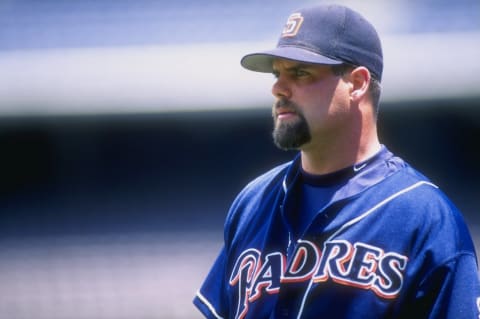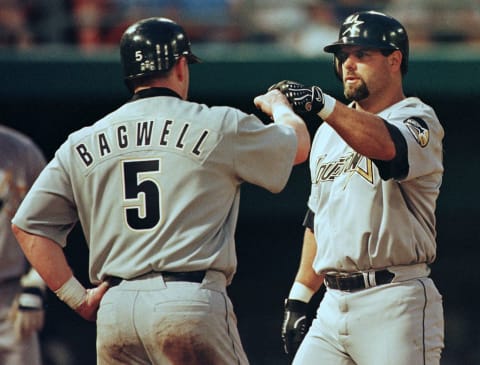Astros: Revisiting 1994 Ken Caminiti trade with Padres

The Houston Astros traded away a franchise star in Ken Caminiti in what turned out to be a lopsided trade.
As we continue looking to the past while the present is on hold, we come to one of the biggest trades in Houston Astros history. A late Christmas lump of coal in fans’ stockings, so to speak, came on Dec. 28, 1994, when the club included third baseman Ken Caminiti in a massive 12-player trade with San Diego.
The full trade sent Caminiti, outfielder Steve Finley, shortstop Andujar Cedeno, first baseman/outfielder Roberto Pentagine and pitcher Brian Williams to the Padres. In return, the Astros got outfielder Derek Bell, pitcher Doug Brocail, shortstop Ricky Gutierrez, pitcher Pedro Martinez (no, not THAT Pedro Martinez), outfielder Phil Plantier and infielder Craig Shipley.
The Astros also sent a player to be named later to San Diego, which turned out to be pitcher Sean Fesh, who never reached the major leagues. The remaining 11 players did play in the majors, however, so we can judge this trade with the benefit of hindsight to see just which team made out better.
The result is pretty clear when you look at it, and it’s a wonder that GM Bob Watson even made this trade. For one, the 1994 Astros only had three players reach double-digit home runs. Jeff Bagwell was the runaway leader with 39, but Caminiti and Finley were the other two. Power was already something of a weakness and they traded away two of their better hitters.
Caminiti was an All-Star that year as well. He was beloved by his teammates and many fans, though he struggled with addiction for many years which ultimately resulted in his tragic death at age 41 in 2004. It’s fair to wonder how both he and the Astros would have fared if he’d spent his best years in Houston.
With that, here’s the analysis of this mega-trade.

What the Astros Gave Up
Caminiti, 31 at the time, was the centerpiece, and he took his career to new heights in San Diego. Some of that can be attributed to leaving the Astrodome, and some to his own admitted steroid use. Regardless, what he did on the field with the Padres dwarfed his time with the Astros.
In four seasons in San Diego, he hit .295/.384/.540 with 121 home runs, compared to .264/.330/.402 with 103 homers in 10 total seasons in Houston. He won three Gold Gloves, was a three-time All-Star and the 1996 NL MVP with the Padres. By the time he returned to the Astros as a free agent prior to the 1999 season, his prime was done.
Finley was the co-headliner, and like Caminiti, he performed better after the trade than he did before it. He was 29 at the time and had put together a .281/.331/.406 line with 32 homers, 88 doubles and 110 steals in four seasons with the Astros. Of course he found his power after the trade as well.
In four seasons with the Padres, Finley hit 82 homers, 134 doubles and stole 85 bases with a .276/.334/.458 line. He would have his best run with the Diamondbacks, hitting 166 homers over the next six seasons.
Cedeno had quietly put together a decent couple of seasons as the Astros shortstop, putting up league average production on offense in the two campaigns prior to the trade. He was only 25, but his performance cratered as he hit just .217/.273/.311 with the Padres. He was sent to Detroit in 1996 along with Brad Ausmus and returned to the Astros in Sept. 1996, but that was his last stint in the major leagues.
Pentagine was just 23 years old and had made a brief major league debut in 1994. But he was never able to establish himself in the majors and lasted only one season with the Padres before being shipped to the Mets.
Williams was a 25-year-old right-hander who was coming off a 5.74 ERA in 1994 split between the rotation and the bullpen. He went 3-10 with a 6.00 ERA in 1995 before the Padres released him. He returned to Houston in 1999 to compile a 4.41 ERA in relief, but was out of the majors after 2000.

What the Astros Got
Bell had just turned 26 and hit .311 for the Padres in 1994. He would be a solid everyday outfielder for the Astros for the next five seasons, getting MVP consideration in 1995 when he hit .334 with 27 steals. He drove in 113 runs in 1996 and had arguably his best season in 1998 with a .314 average, 41 doubles, 22 homers and 108 RBIs.
In his Houston tenure, he totaled a .284/.341/.430 line with 153 doubles, 74 homers and 102 stolen bases. His last season showed a sharp decline at age 30, so the team traded him to the Mets along with Mike Hampton.
Brocail gave the Astros a pair of slightly below-average seasons in 1995 and 1996 before being included in a nine-player trade with the Tigers. He returned to Houston for the final two years of his career and eventually served as the team’s pitching coach.
Gutierrez was the team’s replacement for Cedeno. He was 24 at the time and coming off a .240/.321/.305 season for the Padres. In five seasons, the light-hitting infielder compiled a .266/.337/.340 line with just seven home runs. He hit 21 homers over the following two seasons after leaving the Astrodome.
This Pedro Martinez was obviously not the same as the Hall-of-Famer and Red Sox legend. This one was a 26-year-old left-hander who’d compiled a 2.73 ERA in the Padres bullpen over the previous two seasons. He struggled with walks, though, and that caught up to him quickly as he posted a 7.40 ERA before the Astros traded him back to the Padres the following year.
Plantier spent only a short time in Houston as the Astros traded him back to the Padres in July 1995. He hit .250/.349/.456 in 22 games. The club’s return for him was Rich Loiselle, who never pitched for the team, and Jeff Tabaka, who pitched to a 2.22 ERA in 24 appearances with the Astros in 1995 before posting a 6.64 ERA in 1996 and being let go.
Interestingly, Loiselle was traded to the Pirates in July 1996 in exchange for 40-year-old pitcher Danny Darwin, who struggled to a 5.95 ERA after the trade. Darwin pitched for the Astros previously from 1986-1990 and even led the league in ERA in 1990. But the version of Darwin they got in 1996 wasn’t the same.
Shipley was about to turn 32 and had hit .333 in 81 games in 1994 for the Padres. He played only one season in Houston before hitting free agency, putting up a .263/.291/.345 line with only 12 extra-base hits in 92 games.

The Overall Verdict
This one seems fairly one-sided with the benefit of hindsight. The Astros did get four solid seasons from Bell (plus one not-so-solid season) so it wasn’t a total loss. But what they got from everyone else they received was replacement level or below.
More from Climbing Tal's Hill
- Houston Astros: A Lineup Change to Spark Offense
- Astros prospect Hunter Brown throws 6 shutout innings in debut
- Always faithful Astros World Series champion Josh Reddick defends the title
- Michael Conforto declines Astros’ 2-year, $30 million offer
- Alex Bregman goes off in August, leads Astros
The Padres got four prime seasons from each of Caminiti and Finley, who were both better in San Diego than they had been in Houston. The rest of the players the Astros gave up didn’t do much, so really this swap boils down to Bell in exchange for Caminiti and Finley. Not exactly an even trade.
What it also did was help break up the nucleus of talent the Astros had accumulated. Caminiti was one of the franchise faces next to Craig Biggio, Bagwell and Darryl Kile. He made his first All-Star team as a member of the Astros and was close to his teammates, especially Biggio.
But then again, who knows how things would have turned out if the trade hadn’t been made. There’s no guarantee Caminiti would have won the MVP in ’96 or that the Astros would have been any better off.
But Caminiti probably would’ve had his name in the Astros Hall of Fame if he’d had his best years here. Finley might have even managed that, too, if he’d stayed long enough. The what-ifs are endless.
What we do know is the Padres made out much better in this deal than the Astros did.